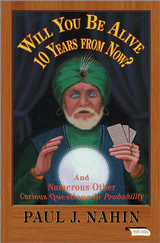Will You Be Alive 10 Years from Now?
|

|
The book is the third of Paul Nahin's collections devoted to probability. (Duelling Idiots and Digital Dice.) It follows the format of the previous two: 25 essays - each with a problem or two and solutions - follow enthusiastic Preface and Introduction. In Preface Nahin does a superb job conveying his passion for the puzzles generously supplied by probability theory. His style is articulate and enticing; if a reader had any interest in picking up the book in the first place, he or she would find it hard to put it back without turning a page or two and, perhaps, browsing the rest of the book. As in the previous books, Nahin uses the opportunity to take to task Marilyn von Savant - a popular Parade magazine's columnist - for the mistakes she made.
The book assumes a certain degree of acquaintance with the basic probability and also a reasonably mature study habits, so that the reader should be able to find the definitions or other probability related notions not explained in the book on his/her own. Some problems are naturally more difficult than others; several go beyond the level of mere puzzles. Many, if not most, require a level of comfort with probability methods beyond that associated with casual audience. Some are intended to a reader with a one-two years Calculus experience.
I can wholeheartedly repeat what I wrote in my review of Duelling Idiots. The problems are truly entertaining and the manner in which the author keeps modifying them is edifying. The book's style leaves no doubt about author's enthusiasm about the subject. For him, the problems provide another opportunity to demonstrate the power of mathematics and the flexibility of its problem solving strategies. But more than that, an experienced writer, the author exploits every opportunity to tell a story: a historic background, a personal note, a real world association. For any one who can follow the author's mathematics, the book is a pleasure to read.
As in the previous books, solutions to the problems are accompanied by MATLAB scripts. I have not put a lot of stock on that in other books, nor in the present one. Nahin expresses an idea that many simple problems are difficult to simulate, while the code is relatively simple for difficult problems. However, all of them wastefully come with the code. For the simple ones, with a solution in a closed form, simulations do not - in my view - add much information or enhance anybody's understanding.
Once I was somewhat disappointed with Nahin's treatment of a difficulty, the treatment that I believe betrayed his engineering background. In the chapter that gave the book the title, Nahin introduces $p(x)$ as the probability that a person alive now will still be alive in $x$ years of time, and then also defines $\displaystyle \phi (x)=\int_{x}^{\infty}p(u)du.$ After some effort, he arrives at the following equation: $p(x)\phi (x)=\phi (x),$ with apparently immediate solution, $p(x)=1.$ The solution implies that a person is immortal. At this point Nahin declares, "This solution is mathematically correct, but is also a physical nonsense (just as, in high school bag we would reject negative or complex solutions as physically unacceptable.)" He rewrites the equation as
$\displaystyle p(x)\phi (x)=\int_{x}^{\infty}p(u)du;$
and then treats and eventually solves that integral equation. A better explanation would be that in writing $\displaystyle \phi (x)=\int_{x}^{\infty}p(u)du$ he implicitly assumed that $p(x)$ is integrable on $[0,\infty)$ which would preclude $p$ from being identically $1$ on half the axis. Every step that preceded the equation $p(x)\phi (x)=\phi (x)$ had to be validated against this prerequisite. This has nothing to do with a high school bag of tricks.
Other than that, the book is a delightful collection that will be appreciated by curious undergraduates and probability instructors as a course supplement.
Will You Be Alive 10 Years from Now?, Princeton University Press, 2014. Hardcover, 242 pp, $27.95. ISBN 0691156808.
The book is referred to at
|Up| |Contact| |Front page| |Contents|
Copyright © 1996-2018 Alexander Bogomolny73435368
